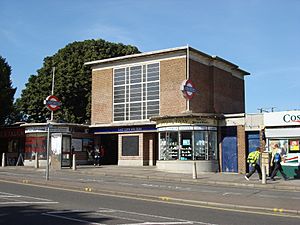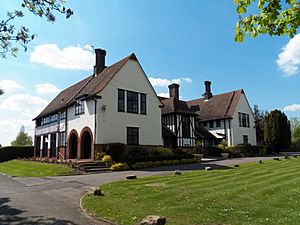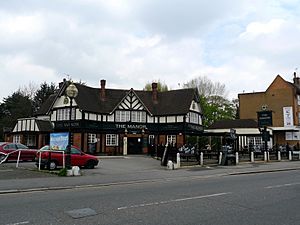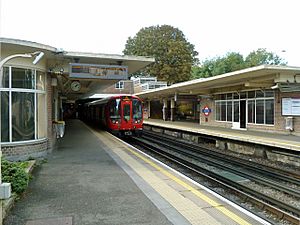Eastcote facts for kids
Quick facts for kids Eastcote |
|
|---|---|
 The dovecote in Eastcote House Gardens |
|
| Population | 12,142 (Eastcote and East Ruislip ward, 2011) |
| OS grid reference | TQ115885 |
| London borough | |
| Ceremonial county | Greater London |
| Region | |
| Country | England |
| Sovereign state | United Kingdom |
| Post town | RUISLIP |
| Postcode district | HA4 |
| Post town | PINNER |
| Postcode district | HA5 |
| Dialling code | 020 |
| Police | Metropolitan |
| Fire | London |
| Ambulance | London |
| EU Parliament | London |
| UK Parliament |
|
| London Assembly |
|
Eastcote is a lively suburban area in West London, found within the London Borough of Hillingdon.
Long ago, in the Middle Ages, Eastcote was known as Ascot. It was one of three main parts of the Ruislip area. Its name came from being located to the east of the parish.
During the Second World War, Eastcote played a secret role. It was home to a special outpost of the Bletchley Park codebreaking team. They used powerful computers to crack enemy codes. This important work later led to the creation of GCHQ, a top-secret intelligence agency. GCHQ stayed in Eastcote after the war until 1952.
A brave woman named Lady Mary Bankes once lived in Eastcote. She became famous for defending Corfe Castle in Dorset during the English Civil War. She stood strong against the attacking forces.
Around the year 1900, Eastcote had about 600 people living there. By 2007, the population had grown to 12,142 people. Interestingly, part of Eastcote uses the Pinner postal code, even though it's in Hillingdon, not Harrow.
Contents
Eastcote's Past: A Journey Through Time
How Eastcote Got Its Name
Eastcote was first called Ascot. It was one of three old areas of Ruislip, along with Westcot and Norwood. Norwood, in the north, became Northwood. Westcot, in the west, became Westcote (the main Ruislip village). Ascot, in the east, became the Eastcote we know today.
Early Buildings and Famous Residents
The Hawtrey family moved to Eastcote around 1525. They lived in a cottage they renamed Eastcote House. John Hawtrey, their son, built a dovecote there. This dovecote is still standing today in Eastcote House Gardens.
Lady Mary Bankes, a famous Royalist, lived in Eastcote. She bravely defended Corfe Castle during the English Civil War in 1643. A special plaque at St Martin's Church in Ruislip remembers her courage. Lady Bankes also lived at Haydon Hall in Eastcote. A local school is named after her.
The first Haydon Hall was built in 1630. It was for Lady Alice, the Dowager Countess of Derby. She used it to store her belongings.
Highgrove House was built in the 1700s. It was rebuilt in 1879 after a fire. Winston Churchill stayed there for his honeymoon. The Queen of Sweden also lived there during the First World War.
Eastcote Grows Up
At the start of the 1900s, Eastcote was a small village. It had about 120 cottages and around 600 people.
The Metropolitan Railway came to Eastcote in 1904. A small train stop, called a halt, was built in 1906. The railway brought many visitors who wanted a day out in the countryside. Local cottages and tea gardens became popular. The Cavendish Pavilion was built in 1914 as a private sports ground. The train halt became a proper station in 1939.
In 1930, land developers bought the Hawtrey family's land. They planned to build the new Eastcote Park Estate. This would have meant knocking down Eastcote House. But the local council bought it in 1937 to save it for public use. Haydon Hall was also bought by the council in 1936.
During the Second World War, Eastcote House was used by the Food Control Office. They were in charge of issuing ration books. Eastcote was bombed 106 times between 1940 and 1941.
The British government built a military hospital near Highgrove House. It was for soldiers injured during the D-Day landings. But it wasn't needed for that. Instead, it became barracks for Navy Wrens.
A secret codebreaking operation from Bletchley Park also set up a base here. It was called HMS Pembroke V. They used 100 Bombe machines to decode German Enigma messages. This important work continued after the war. In 1946, it became the new "Government Communications Headquarters" (GCHQ). They even used two Colossus codebreaking machines. GCHQ moved to Cheltenham in 1954.
In 1952, new houses were built in Newnham Avenue. The Minister for Housing, Harold Macmillan, who later became Prime Minister, visited.
Sadly, Eastcote House was knocked down in 1964 because it was unsafe. But its beautiful walled garden, coach house, and dovecote were saved for everyone to enjoy. Haydon Hall was also demolished in 1967.
The old RAF Eastcote site was sold in 2007. Plans were made to build 385 new homes. This new area is now called Pembroke Park. This name remembers HMS Pembroke V, the secret codebreaking base from the Second World War.
In 2011, a local pub called The Manor was updated and renamed "The Ascott". This new name was chosen by the public, linking back to Eastcote's old name. The Case is Altered pub in Eastcote High Road is a Grade II listed building. This means it's an important historical building.
Eastcote's Neighbourhoods
Eastcote Village is a special part of Eastcote. It's located on higher ground, near Ruislip Woods National Nature Reserve. This area has a park-based conservation area. It includes a cricket pitch, Eastcote House Gardens, and Haydon Hall Park. Another conservation area, Eastcote Park, is also nearby.
Nearby Areas
 |
Northwood Hills | Cuckoo Hill | Pinner |  |
| Ruislip | Rayners Lane | |||
| Ruislip Manor | South Ruislip | Roxbourne |
Who Lives in Eastcote?
The local area for elections is called Eastcote. In 2015, about 12,600 people lived here. Most houses (83.8%) are owned by the people living in them. The average age of residents in 2013 was 44 years old.
Getting Around Eastcote
Eastcote Underground station is served by two London Underground lines: the Metropolitan and Piccadilly lines. This makes it easy to travel around London.
Eastcote also has several bus routes. Route 282 goes to Ealing Hospital and Mount Vernon Hospital. Route 398 goes to Northolt's Wood End Estate and Ruislip. Route H13 passes through Eastcote Village, going to Ruislip Lido and Northwood Hills.
Famous People From Eastcote
Many interesting people have connections to Eastcote:
- Artist Ervin Bossányi (1891-1975) lived here.
- Actress Jessie Matthews (1907-1981) lived in Eastcote.
- Composer Sir Michael Tippett (1905-1998) was born here.
- Actress Luisa Bradshaw-White, known for EastEnders, was born in Eastcote.
- TV and radio presenter Fearne Cotton grew up in Eastcote.
- Actor Bernard Holley, from Doctor Who, was born here.
- Singer Siobhán Donaghy from the band Sugababe.









